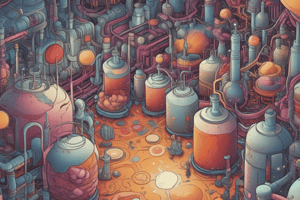Podcast
Questions and Answers
Which of the following are primary metabolites? (Select all that apply)
Which of the following are primary metabolites? (Select all that apply)
- Lactic acid (correct)
- Penicillin
- Insulin
- Ethanol
When are secondary metabolites typically formed?
When are secondary metabolites typically formed?
- During the growth phase
- Throughout the growth cycle
- Near the end of the growth phase
- In the stationary phase (correct)
Total coliform bacteria are indicative of recent fecal contamination in drinking water.
Total coliform bacteria are indicative of recent fecal contamination in drinking water.
True (A)
What enzyme is used as a substrate for detecting β-galactosidase activity in coliform bacteria?
What enzyme is used as a substrate for detecting β-galactosidase activity in coliform bacteria?
Waterborne pathogens can include bacteria, viruses, and parasites. Detection of all waterborne pathogens is _______, time-consuming, and expensive.
Waterborne pathogens can include bacteria, viruses, and parasites. Detection of all waterborne pathogens is _______, time-consuming, and expensive.
What are the six main processes involved in the carbon cycle?
What are the six main processes involved in the carbon cycle?
Which organisms release oxygen as part of the oxygen cycle?
Which organisms release oxygen as part of the oxygen cycle?
Combustion is an abiotic process in the carbon cycle.
Combustion is an abiotic process in the carbon cycle.
What is biomass and where does its chemical energy come from?
What is biomass and where does its chemical energy come from?
Carbon is stored in rocks as _____ (calcium carbonate CaCO3) which can be dissolved in the ocean, releasing carbon.
Carbon is stored in rocks as _____ (calcium carbonate CaCO3) which can be dissolved in the ocean, releasing carbon.
Study Notes
Industrial Microbiology
- Industrial microbiology involves the use of microorganisms to produce various products, including:
- Antibiotics (e.g. Penicillin)
- Ethanol
- Lactic acid
- Vinegar
- Insulin
- Primary metabolites are involved in the growth, development, and reproduction of microorganisms, while secondary metabolites are not essential for growth but play a role in defense mechanisms.
Water Microbiology
- Raw water may contain contaminants from the environment and sewage, including bacteria, viruses, and protozoa that can cause waterborne diseases.
- Drinking water must be free from pathogens and chemicals that are dangerous to human health.
- The first federal drinking water standards were established in 1914 by the American Public Health Service (APHS).
- Monitoring agencies, such as the WHO, EU, FDA, and US-EPA, set standards for safe drinking water and establish maximum contaminant levels (MCLs) for various contaminants.
Microbiological Indicators of Fecal Contamination
- Microbiological indicators are used to detect the presence of fecal contamination in water, as it is difficult, time-consuming, and expensive to detect all waterborne pathogens.
- Indicator organisms are used as a proxy for pathogens, as they are present in higher numbers and are easier to detect.
- A good microbiological indicator microorganism should:
- Be present in higher numbers than the pathogens they indicate
- Be easy to detect by simple methods
- Be non-pathogenic
- Can survive for a longer time to provide time for analysis
- Be useful for all types of water
- Reflect changes in the environment
Fecal Indicator Bacteria (FIB)
- FIB are used to detect the presence of fecal contamination in water and include:
- Total coliform
- Fecal coliform
- Fecal Streptococci
- Enterococci
- Anaerobic bacteria
- Coliform bacteria are a good indicator of contaminated water, as they are members of the Enterobacteriaceae family and are:
- Rod-shaped (bacilli)
- Gram-negative
- Non-spore forming
- Facultative anaerobes
- Capable of fermenting lactose to acid and gas
Detection Methods
- There are two types of detection methods:
- Qualitative analysis: Presence-absence (P-A) using defined substrate technology
- Quantitative analysis:
- Most probable number (MPN) using the quanti-tray system
- Colony counting using Coliscan media
- Defined substrate technology uses enzyme-based methods to detect coliform bacteria and E. coli.
- Commercial kits, such as Colilert and Coliscan, are available for the detection of coliform bacteria.
The Role of Microbes in the Cycle of Elements
- Microorganisms play a crucial role in the cycle of elements, including:
- Oxygen cycle
- Carbon cycle
- Nitrogen cycle
- Sulfur cycle
- Phosphorus cycle
- Iron cycle
- Microorganisms are involved in the production and consumption of oxygen, as well as the decomposition of organic matter.
- The carbon cycle involves the transformation of carbon between its various forms, including:
- Photosynthesis
- Respiration
- Exchange
- Sedimentation
- Decomposition
- Combustion
Studying That Suits You
Use AI to generate personalized quizzes and flashcards to suit your learning preferences.
Description
This quiz covers industrial microbiology, including bacteria, molds, yeast, and their products such as penicillin, ethanol, and lactic acid. It also explores primary and secondary metabolites in microorganisms.




